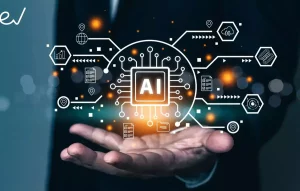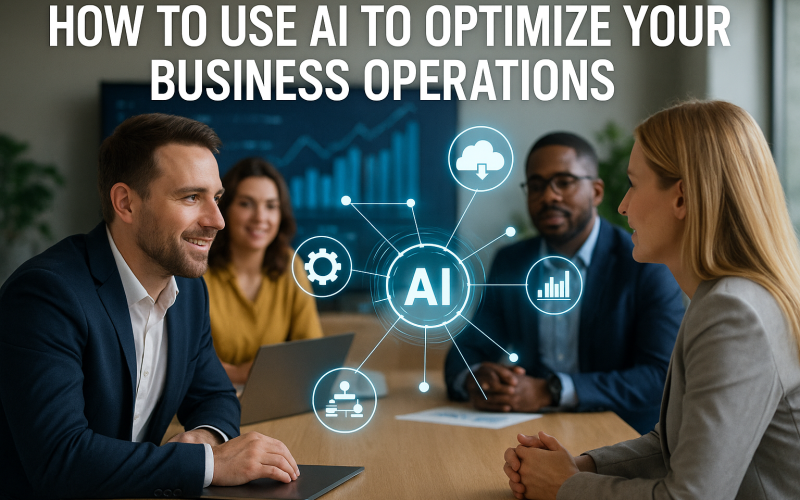Introduction
Running a business today means juggling many tasks at once—customer support, marketing, inventory, finance, and more. In 2025, AI to optimize business operations brings powerful tools to streamline each area. Smart algorithms handle routine work, freeing your team to focus on big ideas. Data-driven insights guide decisions in real time. From chatbots answering questions to AI predicting equipment failures, these advances boost efficiency and cut costs.
This article shows you how to use AI to optimize your business operations step by step. We cover what AI can do, key areas for its use, and practical tips to get started. You’ll also find a handy table summarizing AI applications and benefits. By the end, you’ll know how to plan and implement AI solutions that drive growth and keep your company competitive.
What Is AI in Business Operations?

Artificial intelligence means machines learning from data to make smart decisions. In business, AI can spot patterns in sales figures, predict customer needs, or spot quality issues in manufacturing. Unlike simple automation—like running a report—AI adapts as it gains more data.
Key elements include:
- Machine Learning: Systems that improve predictions over time.
- Natural Language Processing: AI that understands and generates text or speech.
- Computer Vision: AI that “sees” and interprets images and video.
- Predictive Analytics: Forecasting future outcomes based on past data.
When you apply AI in business operations, you turn raw data into clear actions. You might use machine learning to forecast demand or deploy chatbots to handle FAQs. These tools work 24/7, making your operations smoother and more reliable.
In simple words, operations optimization means making every step easier, faster, and more accurate. When AI joins the team, it takes care of the routine work. Teams can then focus on creative and strategic tasks. This blend of human skill and AI power can make a real difference in how a company runs.
How AI Optimizes Customer Support

Customer questions can overwhelm a small team. AI for customer support solves this with chatbots and virtual agents. Chatbots answer common inquiries instantly—order status, returns, or pricing—without waiting on hold.
AI-driven systems also use sentiment analysis. They read customer emails or social posts to detect frustration or urgency. Agents then focus on the most critical cases first. Over time, machine learning refines responses by learning which answers satisfy customers.
Implementation steps:
- Identify FAQs and integrate them into the chatbot.
- Use a platform that offers natural language understanding.
- Train the AI on past support tickets for accuracy.
- Monitor performance and update responses regularly.
By using business automation with AI, you improve response times, reduce support costs, and keep customers happy around the clock.
Benefits of AI in Operations

When you adopt workflow automation, everyday tasks finish faster. AI can sort emails, update records, and schedule meetings in seconds. This frees your team to work on more important projects. The result is smoother operations and less stress.
AI also boosts decision making. Tools that use predictive analytics can look at past data to forecast trends. This tells leaders what may happen next. With these insights, you can plan inventory better, adjust prices, and spot problems early.
Machine learning helps ensure work happens around the clock. AI systems do not need breaks. They can run reports at night, answer customer questions anytime, and monitor equipment even on weekends. This constant vigilance makes your business more reliable.
Finally, AI tools can grow with your business. As needs change, you can add new features or more capacity. You do not have to hire many new staff to handle extra work. You only pay for more computing power, not new salaries.
How AI Enhances Marketing and Sales

In 2025, marketing teams use AI-driven analytics to deliver the right message at the right time. AI segments customers by behavior and predicts which leads are most likely to buy. It personalizes emails, web pages, and ads based on each person’s preferences.
Sales teams use AI for lead scoring and forecasting. Machine learning models analyze past deals to rank new leads. This lets reps focus on high-value prospects first. AI also suggests upsell or cross-sell opportunities based on purchase history.
To get started:
- Collect and centralize customer data from your CRM and website.
- Use an AI-marketing platform for campaign automation and analytics.
- Test AI recommendations on small segments, then scale successful campaigns.
With these time-saving productivity hacks, your marketing and sales become more targeted and effective, boosting revenue with less effort.
How AI Streamlines Supply Chain and Inventory
Managing inventory can be a guessing game. AI in supply chain brings demand forecasting and real-time tracking. Machine learning predicts sales peaks and lulls, suggesting reorder levels. This cuts excess stock and avoids stockouts.
AI vision systems monitor warehouses. Cameras and sensors track pallet locations, flagging misplaced items. Automated guided vehicles (AGVs) move goods efficiently, reducing manual labor.
To optimize your supply chain:
- Collect sales, shipping, and supplier data in one system.
- Apply demand-forecasting models to plan orders.
- Use IoT sensors and computer vision for real-time inventory counts.
- Automate manual processes like order picking where possible.
By embracing business automation with AI, you save on storage costs, speed up delivery, and maintain accurate inventory levels.
How AI Improves Financial Operations
Finance teams handle invoices, payroll, and budgets. AI-driven analytics in finance speeds up routine tasks and spots anomalies. AI tools can scan invoices via OCR (optical character recognition) and match them to purchase orders, flagging mismatches instantly.
Fraud detection models learn normal spending patterns and alert you to suspicious transactions in real time. AI also helps with cash flow forecasting by analyzing past income and expenses, seasonal trends, and external factors.
Key steps:
- Integrate AI with your accounting software for invoice automation.
- Set up fraud detection rules and train models on historical data.
- Use predictive models to forecast cash flow 30–90 days ahead.
This use of AI to optimize business operations means faster close cycles, fewer errors, and stronger financial controls.
How AI Empowers Human Resources

Hiring and retaining talent is a top challenge. AI for HR helps by scanning resumes and matching candidates to job descriptions. Natural language processing understands skills and experience, ranking applicants objectively.
AI can also monitor employee engagement through surveys and performance data. It flags early signs of burnout or high turnover risk. Learning platforms use AI to suggest training courses based on each employee’s skills and career goals.
Implementation tips:
- Use AI-powered applicant tracking systems for fair screening.
These steps streamline HR tasks, improve hiring quality, and boost employee satisfaction.
How AI Boosts Product Development and Innovation
Product teams use predictive analytics to guide R&D and design. AI analyzes customer feedback, market trends, and usage data to suggest features that solve real needs. Virtual prototypes and digital twins simulate product performance before building physical models, saving time and cost.
In agile development, AI can automate testing, bug detection, and code reviews. This speeds up release cycles and improves software quality. For hardware, AI-driven simulations test stress and wear under various conditions.
To leverage AI in development:
- Centralize user feedback and product usage data.
- Use AI tools for simulation and virtual prototyping.
- Automate testing pipelines with machine learning.
By embedding AI-driven analytics into your innovation process, you bring better products to market faster.
How AI Enables Predictive Maintenance

For manufacturing and field service, equipment downtime costs millions. Predictive maintenance uses IoT sensors and AI to predict failures before they happen. Sensors measure vibration, temperature, and pressure. AI models flag anomalies that signal wear or damage.
Service teams receive real-time alerts and maintenance schedules. They replace parts or adjust settings before breakdowns occur. This proactive approach reduces unplanned downtime and extends equipment life.
Getting started:
- Install sensors on critical machinery.
- Train AI models on historical maintenance data.
- Set up dashboards showing asset health and alerts.
- Integrate with work-order systems for streamlined repairs.
With this AI optimization, you lower repair costs and keep production lines running smoothly.
What’s the Future of AI in Business Operations?
By 2030, many say that AI automation will become a basic part of all businesses. They will help business owners plan better, talk to customers in real-time, and fix problems before they even happen.
Also, AI and machine learning will continue to grow together. Machine learning helps AI learn from past work and get smarter without extra programming.
Table: AI Applications vs. Benefits
| Application Area | AI Technology | Main Benefit |
|---|---|---|
| Customer Support | Chatbots, Sentiment Analysis | Faster responses, 24/7 availability |
| Marketing & Sales | Lead Scoring, Personalization | Higher conversion rates |
| Supply Chain & Inventory | Demand Forecasting, Computer Vision | Reduced stockouts, lower costs |
| Finance | Invoice Automation, Fraud Detection | Quicker close, stronger controls |
| Human Resources | Resume Screening, Sentiment Analysis | Better hires, higher retention |
| Product Development | Digital Twins, Predictive Analytics | Faster R&D, better products |
| Maintenance | IoT Sensors, Predictive Models | Less downtime, longer equipment life |
Common Challenges and Solutions
Implementing AI has hurdles. One challenge is data quality. If your data is messy or incomplete, AI learns wrong patterns. To fix this, clean your data before you start. Remove duplicates, fix errors, and fill missing values. Good data makes AI work well.
A skills gap can slow progress. Your staff may not know how to train or fine-tune AI models. To solve this, offer online training courses or workshops. You can also hire a temporary expert or use a service that handles AI setup for you.
Security and privacy are critical. When AI uses customer or employee data, you need to protect it. Choose tools that offer data encryption and follow rules like GDPR or CCPA. This helps you turn AI into a trusted part of your operations.
Conclusion
Using AI to optimize business operations in 2025 transforms how companies run. From customer support chatbots to predictive maintenance, AI brings speed, accuracy, and insight to every department. By focusing on key areas—marketing, finance, supply chain, HR, and product development—you gain a real edge. Start small, pick one area, and integrate AI tools step by step. Clean, high-quality data and staff training are vital for success. Embrace AI today, and watch your operations become more efficient, agile, and ready for tomorrow’s challenges.
Call-to-Action (CTA): Ready to streamline your business with AI? Schedule a demo of our AI operations platform and start your transformation!











